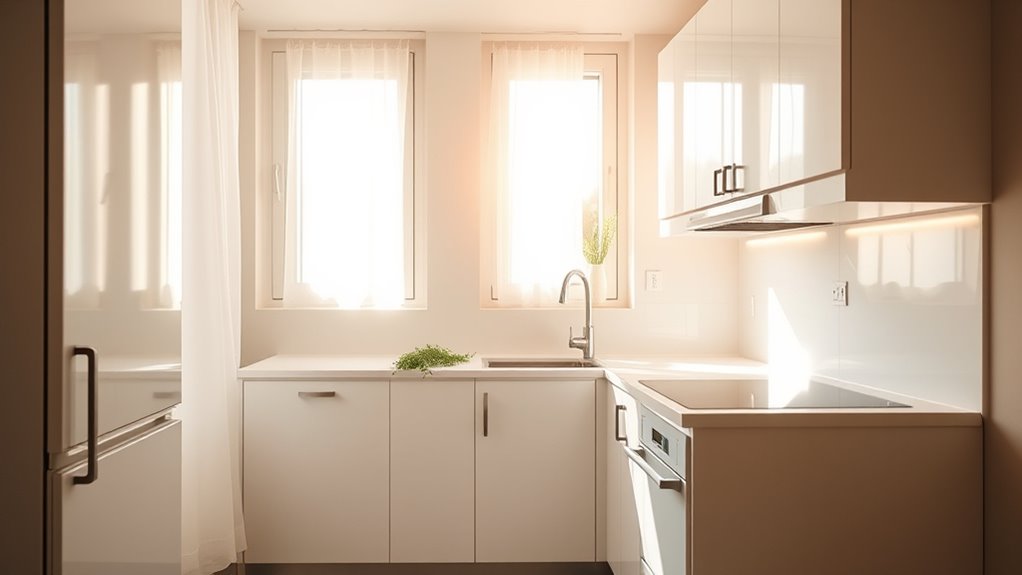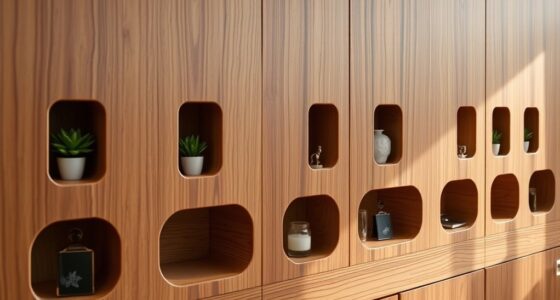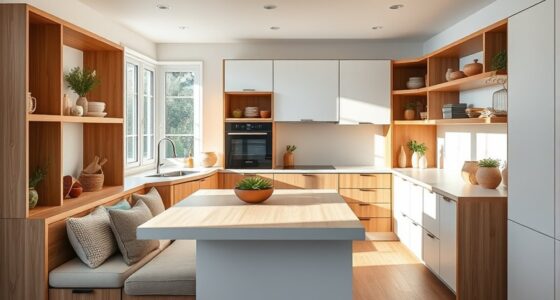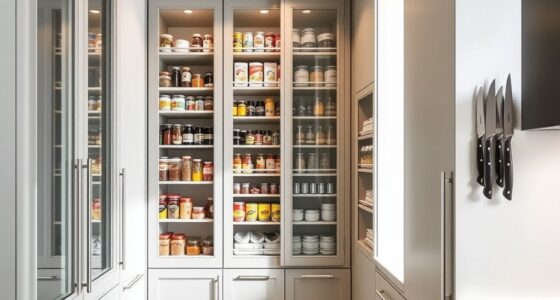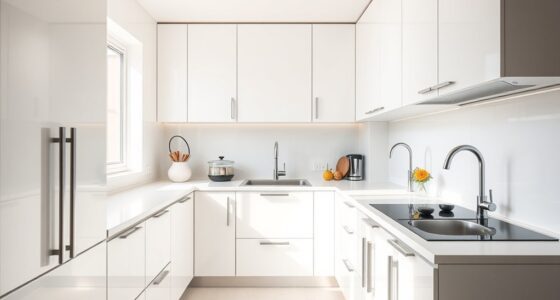To brighten your small kitchen, start with ambient ceiling lights like recessed or warm-white fixtures to create a cozy glow. Add task lighting under cabinets, such as LED strips or puck lights, to illuminate prep areas and boost safety. Combine these strategies with adjustable fixtures for flexibility and avoid shadows or dark spots. By blending ambient and task lighting thoughtfully, you’ll make your space look larger and more inviting—continue with these tips to discover more simple ways to enhance your kitchen’s brightness.
Key Takeaways
- Combine ceiling-mounted fixtures with recessed lights for a soft, even ambient glow.
- Install under-cabinet LED strip lights to directly illuminate countertops and work areas.
- Use warm-white bulbs to create a cozy, inviting atmosphere in small kitchen spaces.
- Incorporate adjustable fixtures for flexible lighting that can be tailored to different tasks and moods.
- Focus on strategic placement to eliminate shadows and dark corners, enhancing overall brightness and openness.
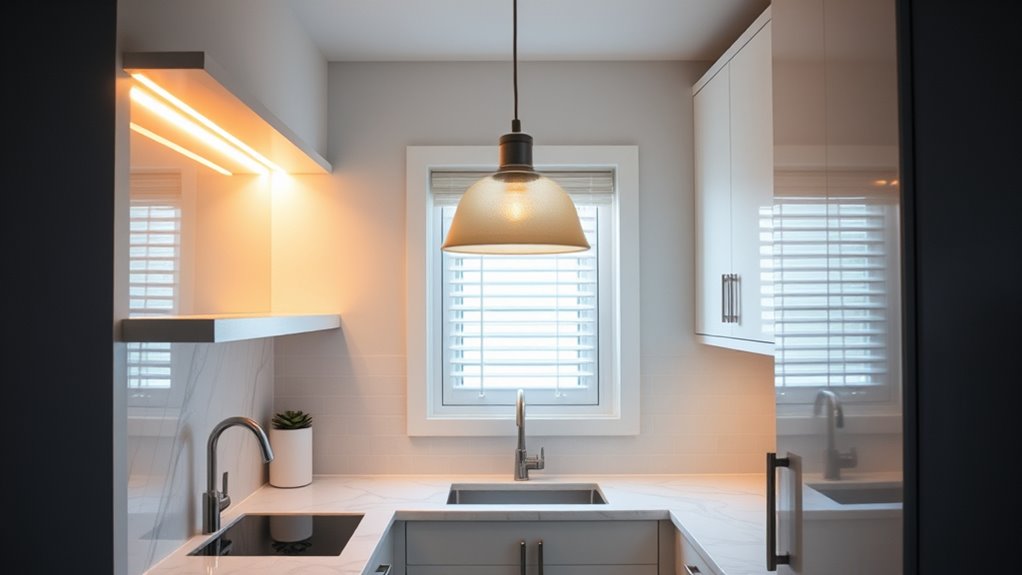
A well-lit small kitchen can feel spacious and inviting, but achieving the right lighting setup requires careful planning. One of the most effective ways to create an open and welcoming atmosphere is by balancing ambient glow with targeted task illumination. Ambient lighting provides a soft, overall glow that fills the space without overwhelming it. Think about installing a ceiling-mounted fixture or recessed lights that distribute light evenly across the room. These options make the space feel brighter and more open without cluttering the limited area. To enhance the ambient glow, consider using warm-white bulbs, which add coziness and make the kitchen appear larger and more inviting.
Task illumination is equally important, especially around areas where you perform detailed work like chopping, cooking, or reading recipes. Under-cabinet lighting is a game-changer in small kitchens because it directly illuminates countertops, reducing shadows and making tasks safer and easier. LED strip lights or puck lights mounted beneath cabinets are popular options that don’t take up extra space and provide focused lighting exactly where you need it. When choosing task lighting, opt for bright, daylight-colored bulbs that mimic natural light, helping you see colors accurately and work more efficiently.
Strategically placing these lights is key. You want the ambient glow to set the mood and make the whole room feel open, while task illumination specifically highlights work zones. Combining these two types of lighting ensures your small kitchen isn’t just functional but also visually appealing. For example, install a ceiling fixture or track lighting that offers adjustable brightness, so you can customize the lighting depending on the time of day or activity. Then, add under-cabinet lights to focus on your prep areas. This dual approach ensures you don’t have dark corners or overly harsh spots, creating a balanced, welcoming environment.
Frequently Asked Questions
Can Natural Light Be Effectively Maximized in Small Kitchens?
Yes, you can effectively maximize natural light in small kitchens. Use light-colored window treatments like sheer curtains to let sunlight in while maintaining privacy. Consider skylight installation to flood your space with daylight, especially if windows are limited. Keep window areas unobstructed and clean to enhance brightness. Combining these strategies will make your small kitchen feel more open, airy, and inviting, all while reducing the need for artificial lighting during the day.
What Affordable Lighting Options Are Best for Small Spaces?
You might think affordable lighting options won’t make much difference, but under cabinet LEDs and pendant lighting options can transform your small kitchen. Under cabinet LEDs provide bright, even illumination without cluttering your space, while pendant lights add style and focused light over counters or islands. Both are budget-friendly choices that maximize light, making your kitchen look larger and more inviting without breaking the bank.
How Do I Choose the Right Color Temperature for Kitchen Lighting?
You should choose a color temperature around 3000K to 4000K for your kitchen, as it creates a natural, inviting lighting ambiance. This range offers a balance between warm and cool tones, helping your space feel bright and lively without being harsh. Consider your kitchen’s style and how you want it to feel; warmer temperatures add coziness, while cooler ones enhance alertness and clarity.
Are Dimmable Lights Suitable for Small Kitchen Areas?
Yes, dimmable lights are perfect for small kitchens because they give you lighting control. You can easily adjust the brightness to suit different tasks or moods, making your space more functional and cozy. Installing dimmable fixtures allows you to customize your lighting without cluttering your space with multiple switches. This flexibility helps you brighten your small kitchen when needed and create a more inviting atmosphere effortlessly.
How Can I Install Lighting Without Damaging Existing Cabinets?
You can install cabinet lighting without damaging your cabinets by choosing adhesive LED strips or puck lights, which require no drilling. Just make certain wiring safety by hiding cables behind the cabinets or along existing wall contours. Ironically, the easiest method keeps your cabinets pristine, letting you enjoy brighter space without the chaos of heavy tools or messy repairs. Safety and simplicity go hand-in-hand, making your kitchen upgrade smooth and damage-free.
Conclusion
By embracing these simple lighting strategies, your small kitchen can shine brighter than ever. Think of it as turning your space into a stage where every detail takes center stage, much like a well-lit artist’s studio. With clever placement and thoughtful choices, you’ll create an inviting, lively atmosphere that feels larger and more welcoming. So, go ahead—let your kitchen’s true brilliance emerge, illuminating every moment and making your space truly unforgettable.
